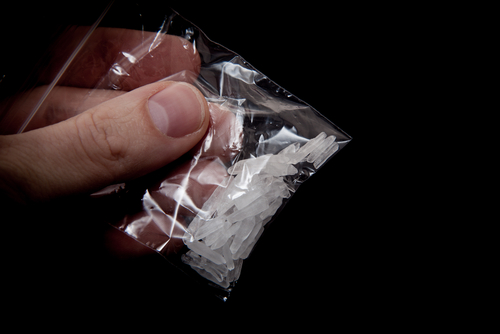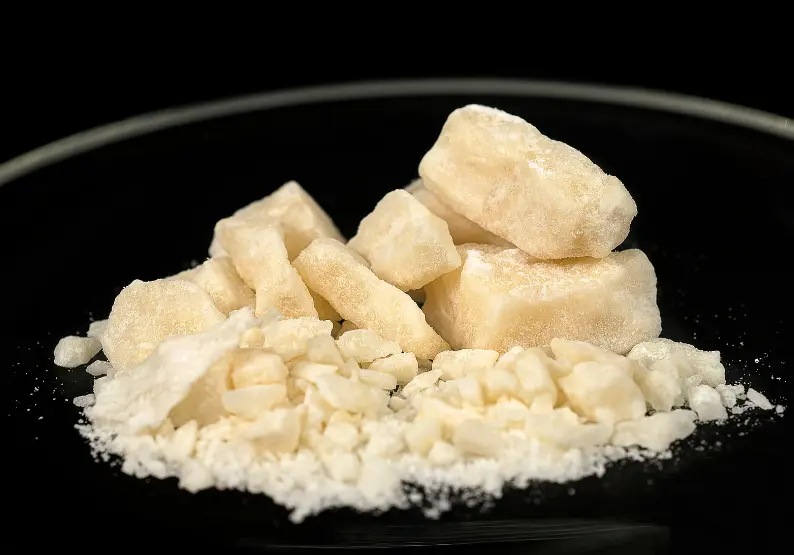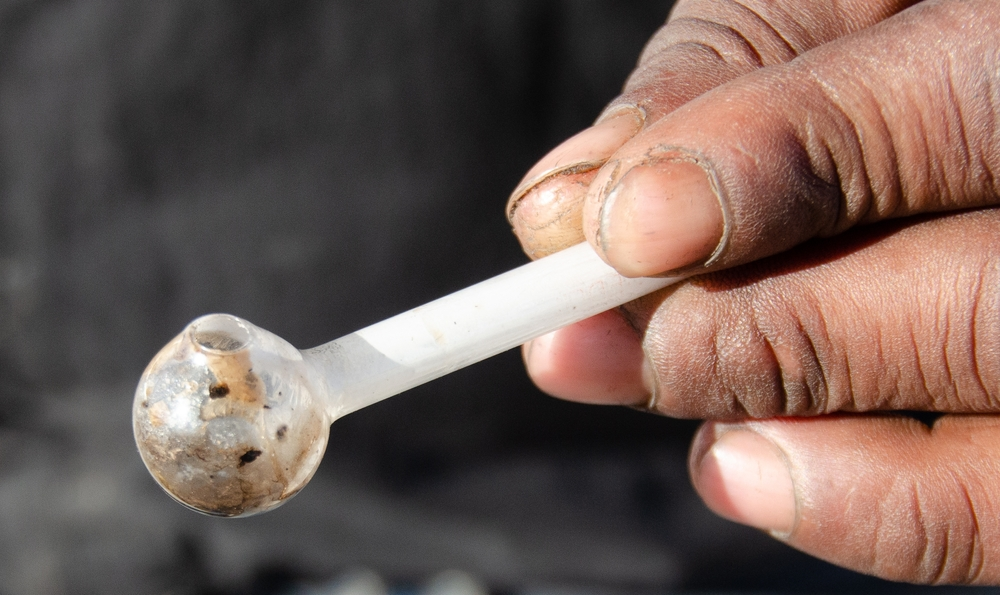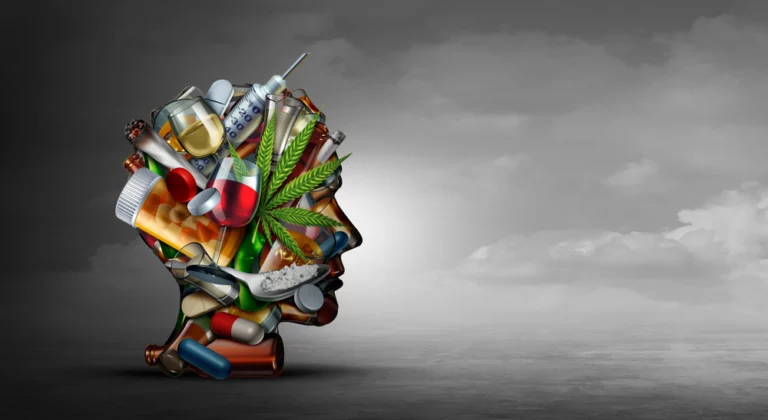In comparing meth vs crack, there appear to be many similarities. Both drugs are highly addictive stimulants and are regularly abused, therefore, it can be difficult to tell the difference between the two. While crack and methamphetamine may appear similar and have similar stimulating effects, they are actually two distinct substances. To fully understand each substance, this article will explore the specifics of crack and meth to show the distinction between them.
What is Meth?
Methamphetamine, or meth for short, is a very potent and habit-forming stimulant that comes in either powder or crystal form. Meth is an artificial drug created using dangerous chemicals and decongestants found on store shelves. It has a powerful effect on the central nervous system, resulting in a euphoric high that does not last long, followed by agitated, over-excited, mad, or scared feelings.
The results of meth intake are felt by the consumer rapidly, although the duration of such effects is usually longer than those of crack. People usually consume meth by following a binge and crash pattern, consuming it at regular intervals to preserve the high. Crystal meth, a kind of meth, is so powerful that someone may become addicted to it after just a few times of usage.

Connect With Us Now
Reach out to us now for immediate support, or let us know the best time to contact you through our confidential callback service. Your journey to healing is just a conversation away.
Short and Long-Term Effects of Meth Abuse
Methamphetamine is a potent stimulant that can keep a person energized and alert, and reduce their appetite even in small doses. It can also lead to various problems with the cardiovascular system, such as a rapid heartbeat, an irregular pulse, and raised blood pressure. Short-term effects of meth include:
- Increased energy
- Excessive sweating
- Euphoria
- Feelings of invincibility
- Insomnia
- Lack of appetite
The long-term abuse of methamphetamine has lots of adverse results, one of them being addiction. Addiction is a consistent and cyclical health problem, demonstrated by a powerful desire to seek and use the drug, and is accompanied by physical and molecular transformations in the brain. As is the case with a number of drugs, tolerance to the enjoyable effects of methamphetamine develops when it is taken over and over again.
Abusers frequently need to dose higher, take the drug more often, or adjust the way they take it, in a bid to reach the desired result. People who are addicted to methamphetamine for an extended period of time may have difficulty feeling any enjoyment apart from the drug, leading to further abuse. Long-term effects of meth include:
- Addiction
- Changes in brain structure
- Psychosis
- Memory loss
- Aggression
- Dental issues or “meth mouth”
- Weight loss
What is Crack?
Crack is cocaine in the form of a crystallized rock. This drug is incredibly addictive and is obtained from the leaves of the coca plant. Despite it being unlawful, it is still commonly used, usually by smoking it through a glass pipe. Even though crack is of plant origin, the chemistry used to make it is dangerous and can be very detrimental to your health. When crack is used, it rapidly reaches the brain and produces a euphoric sensation, yet it only lasts for a few minutes. In order to extend its effects, people who use crack often take multiple doses.

Short and Long-Term Effects of Crack Abuse
The use of crack produces an intense euphoric feeling that is soon followed by a sense of depression, restlessness, and a yearning for further doses of the drug. People who use crack often experience irregularities in their sleep and eating patterns. Additional noticeable effects include accelerated heart rate, muscle contractions, and seizures. The drug can cause feelings of suspicion, anger, aggression, and angst even when not in an altered mental state.
Consuming crack cocaine carries with it a range of health hazards. It is usually blended with other ingredients that generate noxious fumes when burned. Since the crack smoke does not stay potent for long, the pipes used for crack are usually very tiny. This results in cracked and blistered lips, commonly referred to as ‘crack lip’, due to users pressing a very hot pipe against their lips. Other short-term effects include:
- Increased heart rate
- Loss of appetite
- Hallucinations
- Aggression
- Anxiety
- Panic Euphoria
- Rapid breathing
Along with the risks usually associated with cocaine, crack users may suffer from serious respiratory issues such as coughing, lack of breath, lung damage, and bleeding. Long-term use of crack cocaine can lead to significant harm to the heart, liver, and kidneys. Furthermore, users of crack cocaine are more likely to have infectious diseases. Prolonged use of crack cocaine can create sleep deprivation and appetite loss, which can lead to malnutrition.
Smoking crack cocaine has been known to cause aggressive and paranoid behavior. As crack cocaine affects the way the brain processes chemicals, a user needs more and more of the drug to maintain a sense of normalcy. People who become addicted to crack cocaine (like many other drugs) tend to neglect other aspects of life. Long-term effects of crack use include, but are not limited to:
- Liver damage
- Kidney damage
- Respiratory failure
- Severe tooth decay
- Hallucinations
- Psychosis
- Addiction
- Permanent blood vessel damage
- Infection
- Malnutrition
Take Our Addiction Quiz for Recovery Insights
Meth vs Crack
Meth and crack are both stimulants that are highly addictive, but the two drugs have different chemical compositions, with meth being a man-made, synthetic substance and crack cocaine coming from a plant-based source. It’s essential to understand that neither of the drugs is more hazardous than the other, yet both of them can cause addiction, withdrawal, overdose, and severe health issues both in the short and long term.
The phrase “croak” is used to refer to a blend of crack cocaine and methamphetamine. This illicit combination of drugs can contain added ingredients that are hazardous to one’s health. When this combination is smoked, a powerful high is felt but the subsequent crash is much stronger. The combination of crack and meth also increases the chances of severe health problems, overdose, and even death.

Signs of Meth Addiction
It is often difficult to identify when people are using drugs until it has progressed to the point of addiction or abuse. Crystal meth has a particularly high risk of addiction, so it is easy to go from use to abuse to addiction. When someone is using crystal meth, there are certain changes that can be seen, regardless of how long they have been taking the drug. These signs of meth abuse include:
- Extreme weight loss
- Facial scars or scabs
- Being unable to quit
- Rotten teeth aka “meth mouth”
- Poor immunity
- Drug paraphernalia
- Delusions
- Scratching
- Disinterest in things once enjoyed
- Criminal activity
- Insomnia
- Rapid eye movements
Signs of Crack Addiction
Substance abuse related to crack cocaine has various stages. Initially, it might be a person experimenting with the drug because of social pressure or to cope with life issues. Soon, they may start to use increasingly due to the exhilarating high and a way to escape from reality. Eventually, the body and brain become reliant on the drug, to the point that it becomes the focus of their actions. At this point, it is essential to receive specialized assistance to effectively stop using crack. In the initial phases of addiction, the more evident symptoms are not evident yet. However, it is possible to pick up on a few warning signs of addiction:
- Suppressed appetite
- Insomnia
- Paraphernalia
- Nose bleeds
- Bursts of energy
- Muscle twitches
- Mood swings
- Aggression
- Hallucinations
- Extreme weight loss
- Criminal activity
- Inability to quit
Are You Covered For Treatment?
Knoxville Recovery Center partners with numerous private insurance providers. Our team is committed to assisting you in quickly and effortlessly verifying your insurance coverage for treatment.
Treatment for Meth or Crack Addiction
Overcoming addiction to crack or methamphetamine can be very hard. However, it is possible to get help and become sober. Addiction is a chronic brain disorder that necessitates ongoing, customized treatment for long-term sobriety. People struggling with either of these drugs may find medical detoxification, inpatient treatment, outpatient care, sober living, or a blend of all of these services in conjunction with individual therapy and counseling, to be beneficial.

Detox is usually the first step for individuals wanting to overcome addiction to crack and meth. During the detox phase, healthcare professionals such as nurses and doctors can give support from withdrawal symptoms through the use of medications that can help with things like body pain, trembling, and stress. The National Institute on Drug Abuse (NIDA) has suggested that another approach, known as Motivational Incentives for Enhanced Drug Abuse Recovery, which relies on awarding prizes to encourage a person in recovery to stay abstinent, may be extremely effective for many individuals addicted to stimulants.
Addiction Treatment in Knoxville, Tennessee
At Knoxville Recovery Center, individuals struggling with substance abuse are provided with personalized treatment plans to help them on their pathway to recovery. The Center offers a range of therapies from Master’s degree therapists in both individual and group sessions. This is done in order to assist those affected to become functioning members of society again.
There is no need for you to endure your addiction any longer. We are here to help you put your addiction behind you for good. Our wide variety of programs and services can give you the treatment you require and teach you to look on the bright side once again. Don’t wait any longer. Contact us today so that we can begin the process of your recovery. You are not alone in this.








